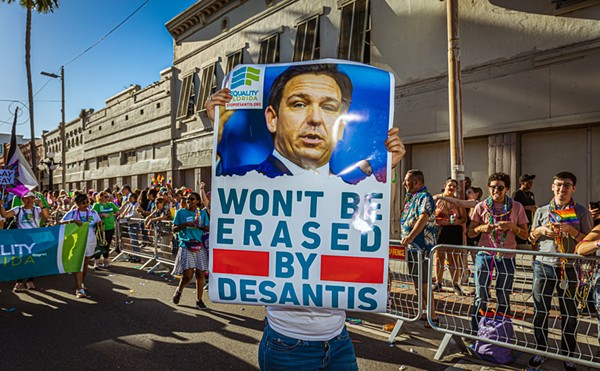George Beasley, a sculpture professor at Georgia State University in Atlanta, has a 40-foot high metal sculpture in that city's downtown. "It's generally understood that metals change," he says. "They're going to develop a patina. One would assume that committee would be well versed in that regard. It's silly to assume that art is somehow bulletproof compared to other things [a county] buys and deals with. If a roof needs replacing, they put a new roof on."
Beasley also faults bad communication and planning. "Almost all public art should have a built-in maintenance schedule," he says. "And often times contracts have setback amounts of money invested toward maintenance."
"Components of Public Safety" has no specific maintenance plan, although the contract calls for Arthur to warranty the work for three years. (The College Art Association of America's Ethics and Guidelines on public art say the artist's responsibility should last no longer than a year.)
In October, the county paid an Orlando area art conservator $900 to interpret the rust issue. John Maseman of the South Florida Conservation Center played it down the middle. His report said that the clear coat Arthur applied might be accelerating the corrosion by "allowing water, salts and oxygen to reach the metal from the edges and holding it there under the intact areas of the layer." But he further concluded that the sculpture "appears to be structurally sound," and "given the nature of this sculpture's construction and shape it would be very difficult if not impossible to apply any surface coating system that would totally prevent corrosion."
Maseman recommended stripping the clear coat and reducing the corrosion chemically or mechanically, then applying two coats of fine wax and polishing it. He declined to offer a cost estimate.
When asked outright if the rust was a defect, Maseman said, "I gave them the condition report. I don't know if I would consider it defective. Metal is supposed to corrode at some point."
If Arthur seems on solid footing with regard to the rust issue, his position seems less strong regarding his claims for additional compensation. His position is this: Doing sculptures of such magnitude is a full-time job. The lengthy delay in receiving the gunmetal cost him new commissions and caused him to incur other expenses.At the project outset, Arthur began communicating with the sheriff's department about the availability of the guns. He dealt with the foundry about the process of recycling the material. When he was denied access to the actual meltdown, he had a deputy videotape it for him.
Why did it take so long to get the gunmetal? The process of cataloguing the turned-in guns lasted longer than expected. By the time Arthur received his billets and rebar last June, his deadline to finish the pieces was already a few months past.
Could one county agency, the public art committee, have intervened with another, the Sheriff, to help Arthur get his gunmetal more quickly? It seems reasonable. But Stein and Fischer say they were not involved in that aspect. Besides, Arthur's contract rendered him completely responsible for procuring material, obtaining permits, buying insurance, even installation.
If he was anxious over the schedule, concerned about losing other work, he apparently didn't let on. It wasn't until late in the game that he started making claims for additional money.
The committee's first inclination was to consider providing him some financial relief. Awarding him an extra $50,000, though, was out of the question. The committee asked the artist to establish his lost work and cost overruns but found his documentation unsatisfactory. "At one point he broke down what he would charge on an hourly basis," Fischer says. "He didn't sign a contract to work on an hourly basis."
Stein was further peeved when Arthur had his pieces put up without a mandatory pre-installation meeting. "At the very least it's rude," she says. "And it's very likely a contractual breach."
Arthur admits that his renegade installations were motivated in part by resentment. But he also worried that the relationship had soured so badly that Stein might prevent him from installing the sculptures altogether.
Despite being left out of the loop, the county decided to leave the pieces where they stand. And where they rust.
Arthur understands that Sheriff's personnel and passersby might not like a large rusting metal star in front of these facilities. "But I don't make signs, I make art." Then he turns more conciliatory. The corrosion carries a more profound message, he explains. "The piece is alive," he says. "You can't stop rust. You can't stop crime. The star itself, made out of stainless steel, will never rust."He would like to see a sign near the sculptures that would explain the ever-evolving nature of the work and its inherent statement.















